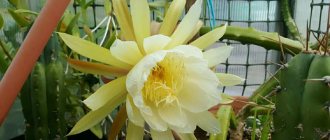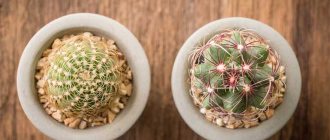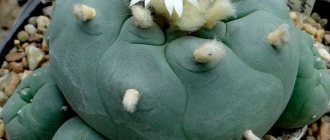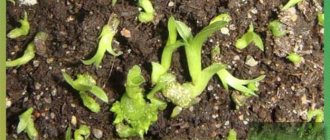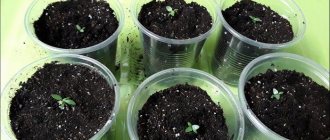Growing cacti from seeds is a complex but very exciting process. Growing cacti from seeds, we observe the entire development process from seed to adult state of these absolutely amazing plants. In this way, you can grow rare species of cacti and succulents that are rarely on sale. And most importantly, cacti grown from seeds will not need acclimatization. But this requires time and patience.
Selection of seed
Choosing seed material is a responsible task, and it is better for novice gardeners to purchase it in a specialized store. To get a plant of pure lines, you should buy seed only from trusted manufacturers or their official suppliers. Leading breeders value their reputation, so they sell seeds with excellent genetic potential and high germination.
Another important point that you should pay attention to when purchasing seed is its freshness, since the shelf life of seeds is only 6 months.
The right time to sow cacti
If you have your own greenhouse equipped with fluorescent lamps, you can sow cacti at any time of the year. Please note that the installation of incandescent lamps is not allowed, because overheating of sprouts can lead to their death.
If there are no sources of daylight in the house, experts recommend postponing sowing until spring. Early spring is the most favorable time for sowing cacti. It is at this time that there is a gradual increase in daylight hours and the intensity of sunlight increases.
Autumn plantings are generally excluded. During this period, nature falls asleep, the rhythm of plant development slows down and seed germination will not give the desired result.
Growing cacti from seeds at home, tips
Among domestic plants there are many exotic species. Some are large in size, while others eat small insects. However, among them there is one undisputed leader - the cactus. This flower strewn with needles is present in almost every apartment. Many people find it quite attractive especially during the flowering period.
It's easy to grow cactus from seeds yourself
The cactus is also loved for its vegetative method of propagation. If desired, it is not difficult to grow a huge plantation at home.
Growing cacti from seeds has some peculiarities, but with a more detailed study on the SEMENA.LIFE website, you can figure out all the nuances yourself.
Preliminary work is an important step towards your own agricultural production. You will need to purchase equipment, study the relevant material and be patient. Under ideal conditions, the first cactus blooms 5 years after planting.
Germinating and planting cactus seeds in the ground
Only proven seeds from the most successful plantations are selected. The process of growing a cactus is long, so if the plant has defects, it will be very disappointing. There is no point in saving on seed purchases.
The first cactus will not bloom soon
The seeds themselves must be washed in an appropriate vessel. Particularly small species are placed on a gauze cloth and doused with warm water. Age remains an important point. You only need to look after fresh material for growing. The best choice remains a term of up to two years.
During germination, it is worth controlling the temperature and humidity according to the requirements of the selected type of cactus. They differ from each other, which makes the whole process complex. The water needs of the sprout are taken into account. For adult species, moisture is not so critical, but for germinated seeds it is vital.
Cacti Cheerful family
The soil, poured into a wide pot, is a combination of perlite and coarse sand. The container needs to be filled more than half, but not to the brim. To prevent the cactus from being damaged by fungus, it is worth considering a drainage system to remove excess water. It is advisable to make several holes at the very bottom so that the main amount of water is retained in the soil.
Small bricks, coarse sand or basalt should be laid on top of the soil in a dense layer. This protective layer will not allow the weed to enter the fertile soil. Cacti require increased protection from fungus and other dangerous plants that will multiply due to them.
The process of growing a cactus
We are building a mini-greenhouse at home. Due to the nature of their growth in the wild, cacti are accustomed to hot conditions.
Approximately the same conditions need to be created inside a homemade greenhouse. All breeders consider the optimal temperature to be up to +25 °C. Of the deviations, variations within 10 °C are allowed. In some cases, a temperature of +15 °C can be considered even useful, but not lower.
Important: breeders advise equipping mini-greenhouses with their own heaters and thermostats. Room temperature cannot be trusted to control cactus growth. Even a minimal draft slows down the growth process due to air cooling, only closed greenhouses with heating elements equipped in them.
Other requirements for a mini-greenhouse:
- placement of the greenhouse is allowed only on the sunny side of the room
- direct sunlight is contraindicated
- When heating the air inside the structure with seeds, room temperature is taken into account
- excess moisture should evaporate freely from the pallets
The process of sowing seeds
The seeds should be scattered close to each other. If you take an area of 2 by 2 cm, you should get up to 20 grains. The cactus is used to growing in families. Thanks to small groups, growth should be more intense than with a solitary planting. After placing the grain on the soil, lightly press it with a finger or other medium-soft object.
Soil is not placed on top of the seeds. The sun's rays during the day should fully illuminate the entire crop area. But in addition to light, you also need water. It cannot be filled with a regular watering can. Breeders take the entire cactus container and place it in a container of water. Only when the top layer is saturated can the moistening process be considered complete (water must flow through the drainage holes at the bottom).
Breeders' advice: 0.5% quinosol will help protect young animals from being affected by the fungus. To prepare the composition, one tablet is dissolved in 2 liters of water. It is not recommended to abuse chemicals.
Watching the growth of a cactus
The cactus itself will emerge from the seed no earlier than two weeks. All this time we water the soil or moisten it in any other convenient way. Moisture in the soil constantly supplies the plant with everything it needs, thereby accelerating its growth.
Don't forget about soil moisture
After four months, the need for a mini-greenhouse disappears. Now the cactus is taken out of the shelter to its usual place in the apartment, but with enough daylight. A window sill is not suitable due to the risk of ultraviolet rays penetrating the plant from direct sunlight. It would be optimal to place the pot on the table near the window.
It will take a few more months for the cactus roots to form. Subsequently, it can be transplanted to any other land. An already formed adult sprout does not require abundant watering. It is sometimes recommended to add potassium phosphate to irrigation water for prevention.
Preparing containers and soil
It is better to plant seeds in a shallow plastic container, the height of which does not exceed 8 cm. The bottom of the cup must have perforation to ensure the free flow of excess liquid. As for the color of the pots, the best option would be white matte containers that are not prone to absorbing sunlight and protect young shoots from overheating. In addition, the cups should have transparent lids that will cover the planted seeds. It is recommended to sow each species separately and mark it with a number or name.
Immediately before sowing, the sowing dishes must be thoroughly washed and disinfected using a strong solution of potassium permanganate or formaldehyde. Ceramic containers can be boiled - this helps get rid of pathogenic microflora and prevent infection of plants.
Cacti grow well in poor soils. Therefore, for sowing, we recommend choosing a special substrate that will have a slightly acidic pH-6 reaction and good water and air permeability. Experts advise making a mixture of coarse sand and leaf soil in equal parts and adding a small amount of charcoal and peat to it. Before adding seeds to the soil, it must be thoroughly disinfected.
Sowing cactus seeds
While the seeds are soaking, a drainage layer 1-2 cm thick is placed in the prepared container and 3-4 cm of the prepared substrate is poured on top. In this case, 1/3 of the pot should remain unfilled. Then the soil is spilled with warm boiled water, and shallow holes are made in it with a toothpick at a distance of 2 cm from each other.
Cactus seeds are laid out using tweezers or a sharp pencil, slightly deepening the large ones and leaving the small ones on the surface. All seeds, except astrophytums, should be placed with the ridge down (astrophytums are sown with the ridge up).
After all the seeds have been distributed among the holes, the soil on top is carefully sprayed with water, the container is closed with a transparent lid and placed in a warm, well-lit place. The optimal temperature inside the greenhouse will be +25 degrees. If the room is too cold, then it will be much more difficult to germinate the seeds, and already at +15 degrees the process may stop altogether. In the future, you can use a spray bottle or watering tube to moisturize. In any case, overdrying the substrate is unacceptable, because can lead to the death of crops.
Rules for planting cacti
You need to start the process by purchasing special soil for cacti.
And then everything is done according to this scheme:
- Remove the seeds and disinfect them to prevent the development of fungi. To do this, you need to take the planting material and place it in a manganese solution for 10-15 hours. It is important to note that the germination rate of swollen seeds is much higher. At the same time, you need to remember that the seeds will not sprout without heat and light, so in mid-February you can make a small greenhouse on the windowsill. A plastic or plastic box is suitable for these purposes.
- At the bottom of the found future greenhouse, it is necessary to make many small holes for ventilation. It would also be a good idea to find a pallet. It will come in handy if the box or box will be moved from place to place.
- Next you need to move on to the ground. When purchasing a soil mixture, it is important to ensure that coarse sand predominates in it. Its share must be at least 50%. The substrate will definitely need to be steamed in a water bath for half an hour. To do this, you can place a colander on top of a pan of hot water, line it with a cloth and pour earth into it, and then close the whole thing with a lid. Upon completion of steaming, remove the pan from the heat, but do not open the lid, because the substrate must cool in this way.
- Having previously disinfected the greenhouse with potassium permanganate or alcohol, it will be possible to fill it with ready-made soil. The layer of soil mixture should be shallow, a few centimeters will be enough.
- After this, the soil is well leveled, small grooves are made in it, retreating from each one by a couple of centimeters.
- All these grooves are filled with seeds. Some gardeners simply scatter planting material on top of the substrate. Of course, if you plant one species, then this can be done. If we are talking about different specimens, then it is much more convenient when there are separate holes.
Important! Before sowing, it is necessary to moisten the soil well with warm water using a tray. It is prohibited to pour water from above.
Considering that the cactus seeds are not sprinkled with soil on top, it will be necessary to immerse them well in the substrate. To do this, you can use a toothpick or tweezers. In this case, you need to take one seed at a time and carefully place it in the prepared groove. The distance between seedlings should be at least 1 cm.
After completing all the manipulations, the greenhouse must be tightly closed with a lid and placed on a lighted window. If there is not enough light, then you should think about an additional light source, which can be a regular table lamp. Seeds should germinate within 10-14 days .
Emergence of seedlings
The duration of illumination of crops should be at least 12 hours a day, which is provided by natural sunlight (spring) or fluorescent lamps (up to 5000 lux in autumn and winter).
A couple of weeks after sowing the cacti, seed germination will become clearly visible, and with the appearance of the first spines, the plants will need to be ventilated daily. Every day, open the container 1-2 times for ventilation and wipe the lid from the inside to prevent moisture from flowing back.
To avoid the appearance of fungus, many breeders recommend using a 0.5% Quinozol solution at this stage, diluting one tablet of the drug in 2 liters of water.
Picking cactus shoots
If mold or algae appear on the surface of the substrate, seedlings can be picked at an early age. However, experienced cactus growers advise postponing this procedure, because it can provoke a temporary stop in plant development.
To dive, remove the seedling together from the substrate using a wooden spatula. Then remove the upper part of the root ball, wash the root collars with a solution of potassium permanganate and replant into a new substrate of the same composition. It is recommended to water cacti after the procedure no earlier than 2 days later.
How does a cactus reproduce?
Cacti can be propagated in several ways. All of them help to obtain new, young seedlings of your favorite plant varieties, of course, subject to planting rules.
Children or cuttings . One of the simplest options is to propagate the plant using stem branches. To do this, “babies” or parts of the trunk are cut off and transplanted into a small container for rooting. The cut planting material is dried for 1-2 weeks. Then, when the cut on the cutting or the child dries out, the plant is planted not too deep into dry soil.
Seeds . When the flowers fade, a seed pod sets in their place. It matures over a long period of time. Seeds form inside. It is very difficult to obtain them at home. First you need to wait for the cactus to bloom. Sometimes it is necessary to ensure the flowering of two unrelated individuals belonging to the same variety at once. Then cross-pollination is carried out using a brush. And only after this the fruits will begin to set, from which the seeds will need to be collected. Of course, it is much easier to buy ready-made cactus seeds.
Today we will figure out how to properly grow cacti from seeds. Why not cuttings? Surely this is much simpler? The fact is that getting an adult plant from a tiny seed is always more interesting than simply breaking off a cutting and planting it in the ground. In addition, sowing cacti in winter is no more difficult than planting, for example, eustoma with seeds.
Further care of cactus seedlings
In order to grow a cactus healthy and strong, it is necessary to carefully maintain the water balance. In this regard, the plant is quite demanding, and with insufficient watering or excessive moisture it can die. The growing cactus should be watered as soon as the substrate has dried to a depth of 1 cm.
A sharp change in temperature for seedlings (over 15 degrees) is not recommended; this leads to rotting of the cacti. The temperature can change sharply during watering and spraying of seedlings. Therefore, for spraying you need to take very hot water, and for irrigation the water must be warm and boiled.
How to germinate and sow cactus seeds
Before planting a cactus from seeds, you should make sure that this variety or genus does not give rise to genetic mutations. If it retains all varietal characteristics, then the process will be exciting. The only thing is that before sowing cacti with seeds, you must follow a few basic rules. Thus, cactus seeds germinate, in accordance with the growth pattern of these plants in general, slowly; seedlings also develop slowly. In addition, although cactus seeds require moisture and warmth to germinate, on the other hand, cactus seedlings are very susceptible to fungal diseases. Therefore, when sowing seeds, you need to maintain the required humidity and temperature and at the same time strive to prevent the appearance of fungal diseases. How to germinate cactus seeds is described in detail in this article further down the page.
Sowing cactus seeds on a larger scale or propagating especially difficult, slow-growing cacti, which often have very small seeds, should only be carried out by experienced amateur cactus growers. The information necessary for this can be found in specialized literature. However, even novice amateurs can try to propagate suitable types of cacti with seeds - for example, fast-growing columnar cacti - if they have simple means. Seed propagation of cacti is an interesting spectacle to watch, and besides, there is always a special attitude towards a plant grown with your own hands from seeds. Therefore, below are some recommendations for sowing cactus seeds.
